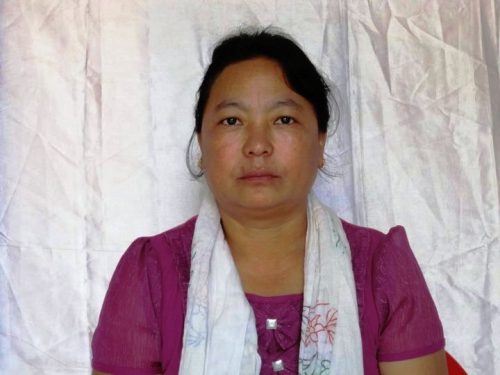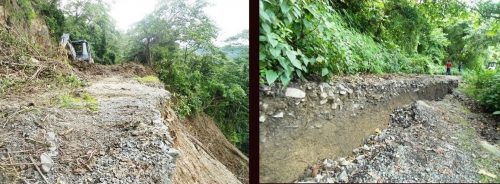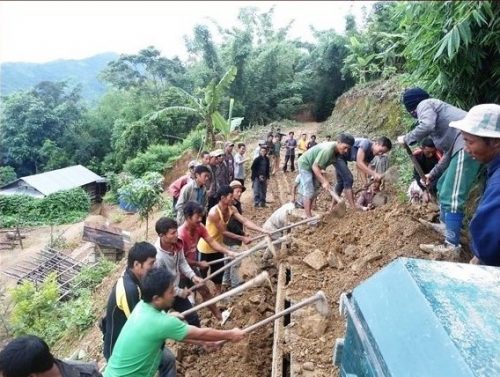TBI Blogs: One Woman Single-Handedly Brought an Entire District Back on Its Feet After the Manipur Floods
The recent floods in Manipur left several towns & villages, including Chandel district, disconnected & in need of urgent help. Shangnaidar Tontang rose to the challenge and helped lead the disaster management efforts.

The recent floods in Manipur left several towns & villages, including Chandel district, disconnected & in need of urgent help. Shangnaidar Tontang rose to the challenge and helped lead the disaster management efforts.
Even thinking about the lashing rains, followed by massive landslides, road cave-ins, a bridge collapse, and hundreds of crumbling homes, brings chilling fear back to her bones. It has taken months for families in Chandel district of Manipur to get back to some semblance of a regular life; a life that was so cruelly destroyed by the unprecedented deluge last year. But if it wasn’t for Shangnaidar Tontang, the affected communities wouldn’t have been able to get through this difficult time. With no previous experience in either emergency response or rehabilitation, these events have been a huge learning for her.
But living amidst the disaster and looking for solutions, keeping women, children and elders in mind, has enabled Tontang to make a difference.

Around 163 villages in the district were badly affected by the flash-floods and the subsequent landslides; in Machi block, 36 hamlets were completely isolated once the communication lines snapped and roads vanished. According to Tontang, this area was already one of the most backward in the region, given the sustained violence they have witnessed over the last few decades.
“From the late 1980s and early 1990s, conflict and violence has become a part of everyday life here. This was the site of one of the worst ethnic clashes between the Kukis and Nagas, and people haven’t really been able to regain a full sense of normalcy since then. Moreover, as it’s a border district, clashes between the army and the insurgents is another regular feature. There are frequent combing operations carried out as well. All this has, unfortunately, ensured that communities are unable to get back on their feet and move forward. There is also a sense of fear among the locals and the disaster seemed to be the last straw. Everything simply came to a standstill,” she shares.
It was as if they had been caught in a nightmare that showed no signs of ending. Roads linking the small villages dotting the countryside were wiped out, bridges and several culverts were either damaged or swept away by the raging waters, and homes at the riverfront were submerged. Crops and vegetables fields were gone.
“Without food, drinking water or medical care, and worst of all, no means to get in touch with each other, things were on a downward spiral. I clearly remember the shock I felt when I heard the news of a nine-member family being buried alive in the landslide at Joumuol village where the disaster claimed 21 lives. Those were some really difficult days that have stretched into months now,” she says, her eyes clouding with pain.
Although Tontang, who runs the NGO, Weaker Sections Development Council (WSDC), was already working at the grassroots level with women on livelihood issues, she found she had to switch gears in the aftermath of the natural calamity. “We basically work for women’s empowerment and on development initiatives. But when disaster struck, my colleagues and I decided to concentrate on relief work,” she explains.
While this wasn’t something any of them had ever attempted, in view of the prevailing emergency, they went ahead anyway.
“We started off by touring the area on foot. There were no roads left so it was not easy to traverse long distances but that was the only way to assess the actual extend of damage and see what needed our immediate attention,” she says.

Incidentally, even when her team and she were out in field, the rains hadn’t ceased, making their survey activity harder than it already was.
Their initial investigation gave them clarity on the way forward. Given the widespread destruction of basic infrastructure, they realised that without heavy machinery, it would be impossible to clear the larger debris.
“Nonetheless, we knew we couldn’t just keep waiting around for relief to come from outside. There was an urgent need for food and other supplies and nothing would reach the people if the pathways were blocked. So we began by mobilising villagers to join us in clearing the internal roads that were inundated with mud and fallen trees,” she elaborates.
This wasn’t ideal because families were in a state of shock; however, Tontang and her team managed to motivate them to overcome their grief to ensure their survival. “We were in it together and I was ready to lead from the front; that finally galvanised them into action,” she reveals.
The going was tough. There were continuous setbacks owing to the unrelenting downpour: “With a lot of effort, we would clear some area only to find it blocked once again in a matter of hours,” recollects Tontang. They somehow managed to make the smaller village roads serviceable, but by then, Tontang had understood that “physical work by the villagers and us” wouldn’t take them far.
“Once I figured this out, the WSDC team and I started working on raising funds and managed to get assistance from humanitarian agencies such as the TATA Trust, CASA and SPHERE India, among others,” she says. With these funds in hand, the WSDC hired a JCB crane.
“The roads had to be cleared in a big way and we needed proper equipment to get the job done quickly. The money came to us at the right time,” she remarks.

What about government aid and intervention? “The administration had their job cut out as well. They were concentrating on getting the major trade routes to the region operational, especially the Indo-Myanmar road and another that leads to capital, Imphal. These are key for movement of supplies and other aid. But we couldn’t wait till they managed to clear up those roads and come to us,” she says.
For 45 days, the JCB crane was deployed to clean out roads for up to 70 kilometres, enough for families to make their way to the nearest town, located in the adjoining Thoubal district. At the same time, this enabled rescue materials to be brought to them.
“For nearly two months, no one had been able to go for work or buy their daily provisions, including food. There was no way to get medicines or go to the hospital at Kakching in Thoubal. With the roads becoming accessible, mobility was restored and government vehicles with medicines, clothes and other things could come in without any problems,” narrates Tontang.
Of course, it was quite a while before people were able to emerge from the trauma of battling such extensive devastation and deep personal loss. “Communities have had to overcome loss on several fronts. They lost their family members, homes, livelihoods and, for the longest time, weren’t able to get back on their feet. Whereas the road blockages resulted in people not making it to the hospital in time, later on, water logging lead to the spread of water borne diseases. With their schools in Thoubal, children had to put their studies on hold temporarily,” says Tontang.
Income generation became the biggest hurdle. “The main sources of earning here are agriculture, handicraft and handloom, and the sale of forest products like wild vegetables and firewood. The disaster had put a stop to all these activities,” says Tontang.

Today, the determined activist has taken on the task of preparing her people for any impeding disaster by introducing awareness programmes and rehab services. “We were caught unawares last year and had to struggle to find a foothold. In fact, for many, the painful memories haven’t faded yet. We are conducting regular trauma counselling to help them deal with it. Besides this, we are doing trainings to empower communities to tackle floods and landslides. Though disasters cannot be predicted, we will definitely be better prepared, emotionally and physically,” she says.
Though India’s disaster management capabilities are still not optimum, efforts like those heralded by Tontang are heartening and show the way forward.
Like this story? Or have something to share? Write to us: [email protected], or connect with us on Facebook and Twitter.
NEW: Click here to get positive news on Whatsapp!
If you found our stories insightful, informative, or even just enjoyable, we invite you to consider making a voluntary payment to support the work we do at The Better India. Your contribution helps us continue producing quality content that educates, inspires, and drives positive change.
Choose one of the payment options below for your contribution-
By paying for the stories you value, you directly contribute to sustaining our efforts focused on making a difference in the world. Together, let’s ensure that impactful stories continue to be told and shared, enriching lives and communities alike.
Thank you for your support. Here are some frequently asked questions you might find helpful to know why you are contributing?


This story made me
-
97
-
121
-
89
-
167











